9 Ways To Use White Wine In Your Cooking
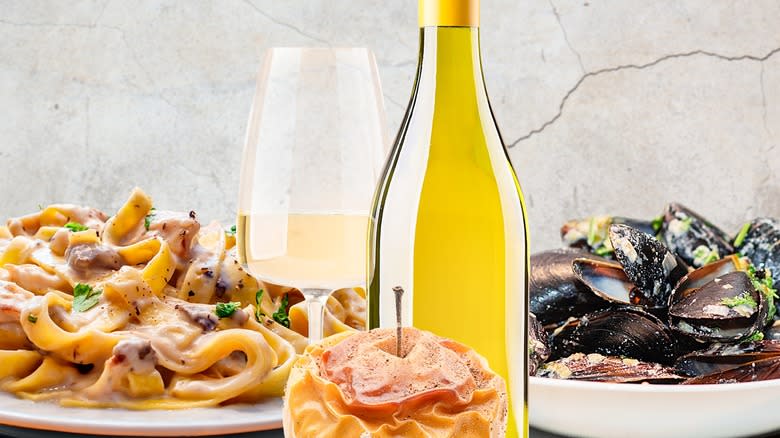
Wine and food have always made a delicious pair, but food is even more delicious when wine is used to cook it. In culinary school, I learned to think of wine as an ingredient, not just an accompaniment served with a meal. Recipes featuring red wine like beef bourguignon and coq au vin are common, and white wine deserves a place not just in your wine glass but also as part of your cooking arsenal.
Whites are an exceptional cooking wine for many reasons. They add brightness to dishes, enriching their flavor without overpowering it. White wine can add balance to a dish, and much like salt, it elevates the taste of each ingredient, lightens heavy stews or soups, creates the creamiest fondues, and helps reduce acidity when it's used as a replacement for vinegar. A splash of white wine can transform ultra-rich, dairy-based sauces into perfectly nuanced pools of deliciousness.
Look to white wines like sauvignon blanc, pinot grigio, and dry sherry for versatility in cooking and great taste. Whichever white wine you choose, ensure it's not a cooking wine sold in grocery stores. These wines are often incredibly salty, and cooking will only intensify their poor taste. Choose a mid-level white wine, one good enough to drink but not too expensive. The flavor of the wine will transfer to your dish, so make sure it's a taste you enjoy. You can use white wine generously in everything from sauces and sides to desserts. Here are some ideas.
Read more: Vinegar Cooking Hacks You'll Wish You Knew Sooner
To Cook Starches
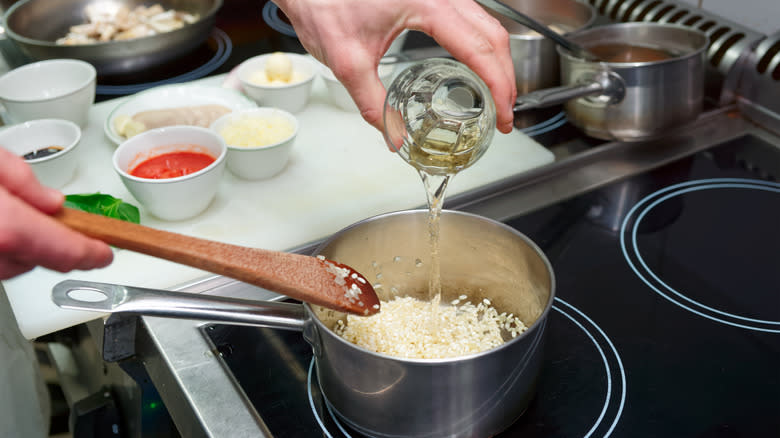
If you're not using white wine to add fantastic flavor to your starches, you are truly missing out. When cooking starches, the first liquids that come to mind are likely water and broth or stock. We've all added instant rice to a pot of boiling water or made a pilaf with vegetable or chicken broth. While these may not be the most flavorful ingredients, they're items you likely already have in your pantry, and they get the job done.
Adding a crisp white wine to your rice transforms it into something spectacular. White wine infuses the rice with a pleasant acidity, creating a tasty contrast to the subtle flavor of the rice. You can replace all or some of the water called for in your recipe with white wine. To start, you can test the waters, pun intended, by replacing half the water with wine and adjusting the amount as necessary to find the level of flavor you like best.
Most risotto recipes also call for a generous glug of white wine added to the arborio rice after it's toasted before adding the stock a ladle at a time. The wine adds moisture to the rice and a crisp, citrusy note that melds nicely with the savory combination of stock, cheese, and the aromatics in your risotto. Always select a dry white wine when cooking starches. Wines with a sweeter flavor profile will alter the taste of your finished dishes, making them unpleasantly saccharine.
Deglaze Your Pan With White Wine
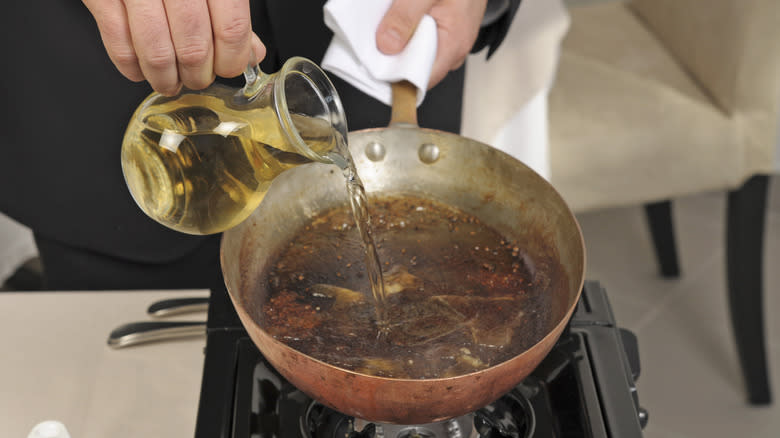
Learning to deglaze is a fundamental building block that will improve the taste of just about everything you cook. It might sound like a complicated task, but deglazing is a simple technique that produces big flavor results. If you've ever sautéed something in a pan and then added a liquid, you're already a member of Team Deglaze.
Deglazing means adding liquid to a pan after you've used the pan to sauté or roast food. When you cook in a hot pan, tiny bits of food stick to the bottom. These bits are called fond, and you should think of them as the fond-ation of flavor in your dish. When you deglaze, the liquid loosens the fond and any spices or seasonings from the bottom of the pan, making it simple to use a wooden spoon to stir all that flavor into your dish.
White wine is an excellent choice for deglazing because it adds flavor from the fond but also from the wine itself. Most recipes call for several tablespoons up to a cup of wine to deglaze. The amount of wine depends on your pan size and what you're making. Pan sauces require only a few tablespoons to impart flavor because there's less volume. You'll need more white wine to deglaze soups, stews, and braises, which require much more liquid to complete your dish. Too much wine will take too long to reduce and might negatively alter your finished dish.
White Wine Elevates Desserts
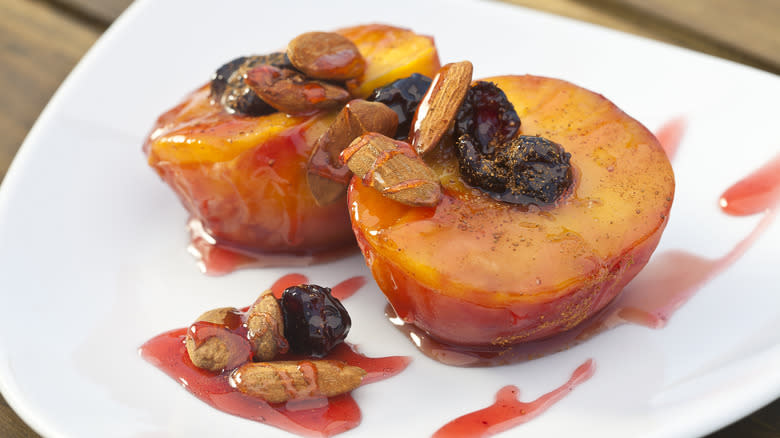
White wine is a key ingredient in many dessert recipes, like poached peaches and baked apples, but it's more than a one-trick ingredient. Off-dry or sweet white wines add a natural sugar to desserts, especially fruit-based ones. Simmering the fruit in wine allows it to absorb the wine's flavor. The result is a tender flesh balanced with a mild acidity. It can also produce a slightly thickened wine for use as a sauce. Sweet red wines can produce the same result, but their stronger flavor can overpower the fruit, while white wines get the job done without diminishing the fruit's flavor or altering its color.
Similarly, baking with wine can also add moisture to your sweet treats and give your cookies, brownies, bars, and alcohol-infused cakes improved crumb and texture. Add a splash of white wine to a boxed cake mix or your homemade cake batter, or replace a portion of the other liquids called for in your recipe, like water or milk, with white wine. Another place you can use white wine while cooling is as a replacement or supplement extract while baking. A dash of white wine will even amplify the flavor of your favorite frostings.
To Steam Food
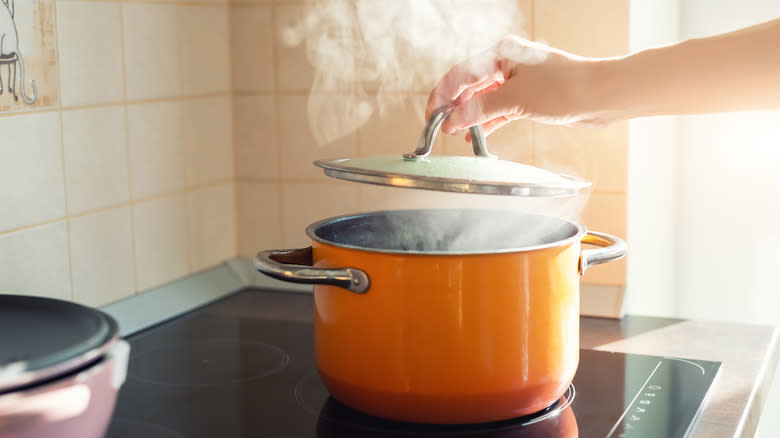
Steaming is a simple way to cook everything from vegetables to seafood. It's a gentle cooking method that many people avoid because steamed food has a reputation for being bland. One surefire way to avoid tasteless steamed food is to grab a bottle of white wine. You can add the wine to the water or replace the water altogether. Like water, wine will produce steam that will gently cook your food, and steaming with white wine will infuse the food with the characteristics of your wine. You can also consider selecting a wine without a bold flavor or bouquet to keep things neutral. Choose a crisp, dry white wine, like a pinot grigio, to steam seafood and shellfish and a light wine like sauvignon blanc for vegetables.
To use white wine while steaming food, pour the wine or wine and water into a pot large enough to accommodate the food without crowding. You can also add herbs, garlic, or sliced onions for additional flavor. Bring the wine to a simmer and place your food into a steaming basket. If you don't have a steamer basket, ball up aluminum foil and place it at the bottom of the pot. It's imperative that the food is elevated so it doesn't touch the water and the steam can circulate freely around the food. Cover the pot with a tight-fitting lid to keep the steam inside, and don't remove it until the food is done.
Sauté Vegetables
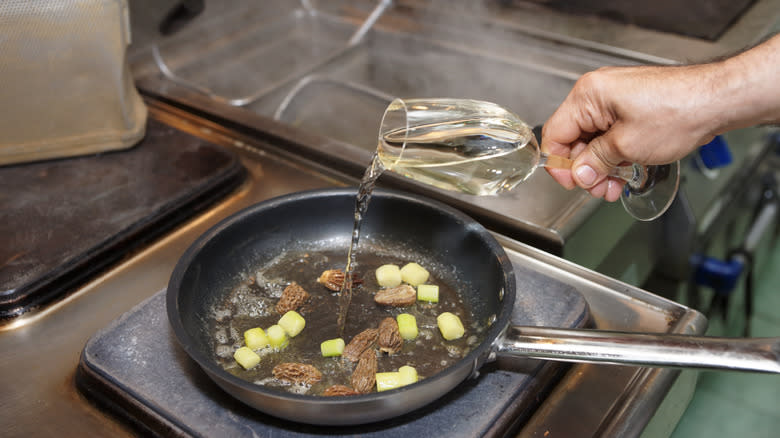
Sautéed vegetables are an easy way to get a side dish on the table in a matter of minutes. Add chopped or sliced vegetables into a hot pan lightly coated with oil and cook, stirring occasionally, until the vegetables are crisp-tender. This technique requires cooking more wine for a long period than simply deglazing, but the vegetables benefit from the flavor of the wine, and the added moisture the wine provides helps cook the vegetables a little faster.
Wine is flammable, so you must be careful when adding it to your pan. British celebrity Chef Marco Pierre White recommends adding the wine to the pan by pouring it around the edge of the pan. The wine will naturally move to the center of the pan. This method ensures the wine hits the bottom of the pan without leaving uncooked wine on top of your vegetables. Heat from the bottom of the pan allows the sugars in the wine to caramelize, mellowing much of the acidity. Be careful not to add too much wine to your pan, lest you poach or braise your vegetables instead of sautéing them.
To Boost Flavor In Processed Foods
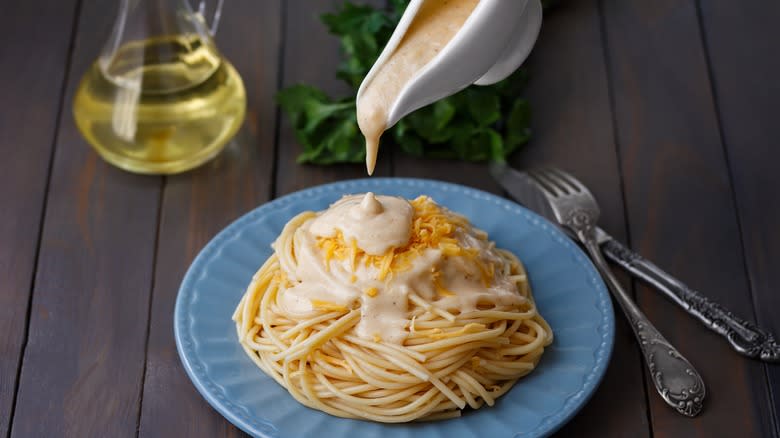
Processed and prepackaged foods aren't typically known for tasting as delicious as their homemade counterparts, but there's no denying their convenience. Busy cooks rely on these easy-to-prepare foods to take the stress out of meal times by providing uncomplicated options that make breakfast, lunch, or dinner in minutes a reality. Using processed foods doesn't have to mean a lifetime of tasteless meals; turn your favorite processed or prepackaged foods into mealtime magic with white wine.
You can quickly level up your favorite jarred Alfredo sauce with the addition of white wine. Like salt, wine brings out the flavor in foods, and adding it to a jarred sauce is an easy way to transform it into a tastier version. Add the white wine as you gently heat the sauce. Stirring it in to taste to turn your jarred sauce into something special.
Instant mashed potatoes are another processed food that will benefit from a generous splash of white wine, though adding the wine directly to the potatoes would result in a harsh taste. Simmer the wine first so that it decreases in volume and concentrates the flavor; you'll only need a few tablespoons of your reduction to elevate instant mashed potatoes. You can get additional flavor by adding herbs, chopped shallot, onion, or garlic to the wine as it reduces.
Use White Wine To Braise Food
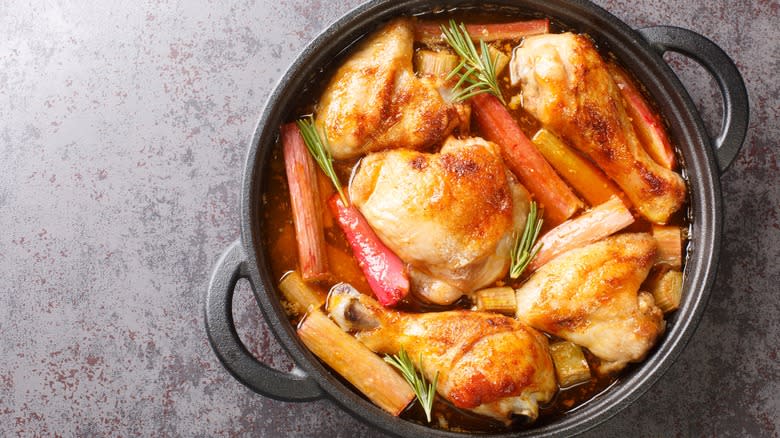
Braising is a cooking technique that relies on a liquid to cook through a long, low, and slow process. For this reason, the braising liquid you choose is just as important as the food you're braising because it's where the bulk of your flavor will come from. Red wine and stock or broth are the most common braising liquids, but white wine is another delicious option. You can braise vegetables and protein in white wine to create full-flavored dishes with extra depth. Depending on the type of white wine you choose, it can add a pleasant fruit-forward acidity to your food.
When braising, proteins are typically browned, and aromatics, like onion or garlic, are sauteed in the pan alongside herbs and spices to build layers of flavor. Only then is the braising liquid added. With vegetable dishes, however, browning them before adding your braising liquid is optional. Using the right amount of white wine while cooking is critical for the braising process. You should add enough to cover between ½ to ¾ of the sides of the food you are braising.
As A Marinade
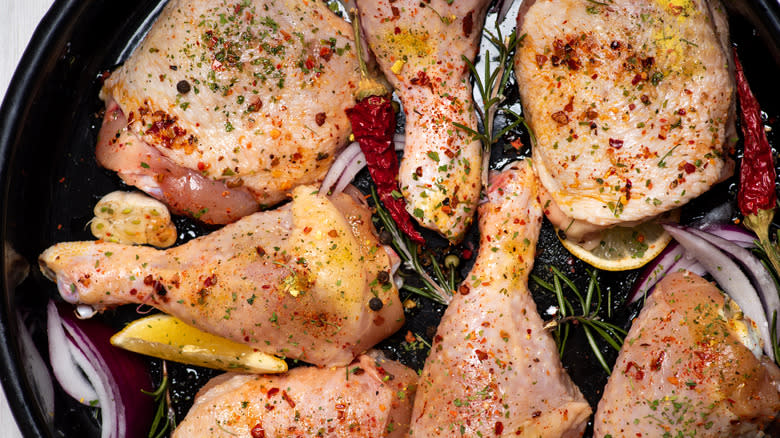
Marinades are an excellent way to build flavor in food, and adding a little white wine can transform a simple seasoning into something phenomenal. This is an excellent method to use white wine in your cooking since, after salt and pepper, its flavors can replace the need for any additional herbs, spices, or citrus.
Still, every good marinade contains acid and fat, so combining your seasonings of choice with white wines will deliver a crisp and slightly acidic finish. Drier whites that are known for having a bite, such as sauvignon blanc, are best for marinating. As mentioned, you can use white wine as your marinade's only acid or use it paired with additional citrus juice or vinegar. The acid in the wine serves two purposes in a marinade. In addition to passing its trademark taste to the food, the acid also helps tenderize the meat. The type of wine you choose can make a major difference in the outcome of your final dish.
Poaching
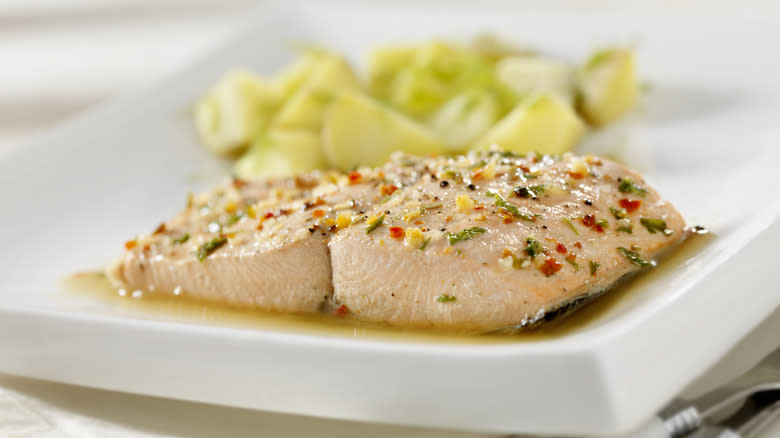
Poaching, which entails gently cooking food in a liquid, is another cooking method made better by white wine. As with other cooking techniques, poached foods benefit from the flavor of the liquid used to cook them. The better tasting the white wine is, the better your food will taste.
Fish and fruit are commonly poached foods. They both cook quickly, and the gentle simmer makes them tender and moist. Not to be confused with braising, poached foods are typically completely submerged. The wine should never be allowed to boil for long, as most poached foods are delicate and might not withstand the intensity of a rolling boil.
A recipe for poached branzino with beurre blanc sauce uses a dry white wine and a bit of Pernod, an anise-flavored liqueur. The fish is thin and tender, so it only requires about 20 minutes to cook. Poached salmon with dill sauce is another favorite. The fish is cooked in a mix of chicken stock and white wine to create a savory, fragrant dish that's simple and elegant. Peaches that aren't quite ripe are perfect for this poached peach recipe, where the sugars in the wine soften the bitterness in the underripe fruit.
Read the original article on Tasting Table.

